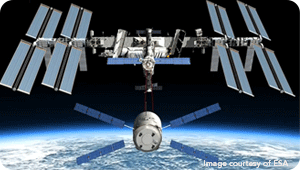The final ATV leaves the Space Station

As scheduled, ESA’s final Automated Transfer Vehicle, the ATV Georges Lemaître, undocked from the International Space Station at 13.42 UTC on Saturday 14 February to embark on its last solo voyage before controlled destructive reentry, marking the end of its mission and also of the whole ATV program.
The last of five Automated Transfer Vehicles, Georges Lemaître has had an event-filled mission that has displayed the spacecraft’s versatility. ATV-5 was launched only nine months after predecessor Albert Einstein finished its mission to supply and reboost the orbital complex. ATV-5 is the heaviest spacecraft ever lofted by an Ariane rocket, and delivered 6617 kg of supplies and experiments to the Station. Before docking, it flew under the Station to demonstrate new laser and infrared imaging technology that will help future spacecraft to rendezvous with uncontrolled objects.
The programme ATV has served the Station with the most complex space vehicle ever developed in Europe, achieving five launches in six years following its 2008 debut. ATVs delivered more than 31.500kg of supplies over the course of their five missions. They boosted the Station to raise its orbit numerous times and similarly moved it out of the way of space debris. The vehicles demonstrated European mastering of automated docking, a technology that is vital for further space exploration.
GMV has been involved right from the start of the ATV mission, taking part in ESA’s preliminary navigation studies, providing mission analysis support for the CNES, developing the operational flight dynamics system (FDS) for the CNES’s Control Center, with the CNES as prime contractor.
GMV also furnished in situ support for flight dynamics operations throughout the whole ATV-1 mission, from blast-off to destructive reentry. It is the only Spanish firm that has worked in the CNES’s Toulouse Control Center.
For the ATV-2, ATV-3, ATV-4 and ATV-5 spaceflights, GMV has been responsible for maintenance and updating of the orbital mechanics system to bring it into line with any vehicle changes with respect to its forerunners and also for improving the system in light of the lessons learned in each flight. Still a member of the orbital mechanics operations team, GMV is also responsible for the orbital mechanics database for operational deployment of flight dynamics and for pre-flight system qualification tests.
While this is the last of the ATV flights, the knowhow and technology that have gone into the series will soon fly again as early as 2017 to power NASA’s Orion spacecraft with the European Service Module, paving the way for the next era in space exploration.